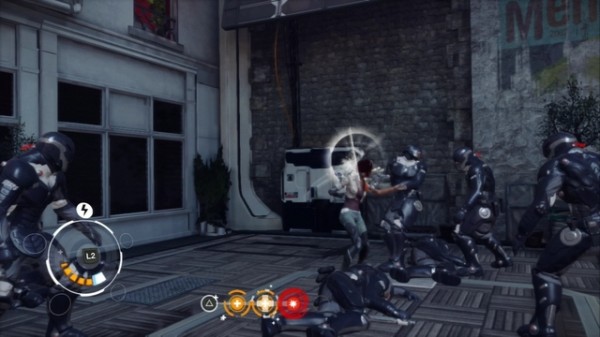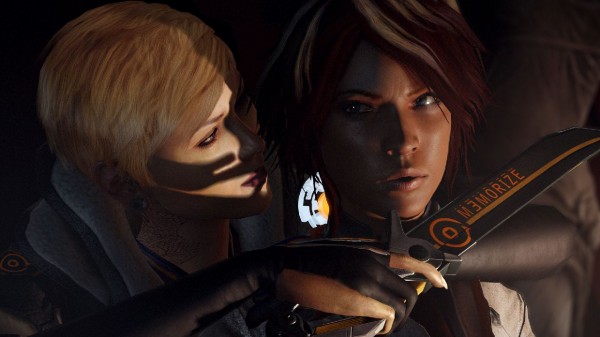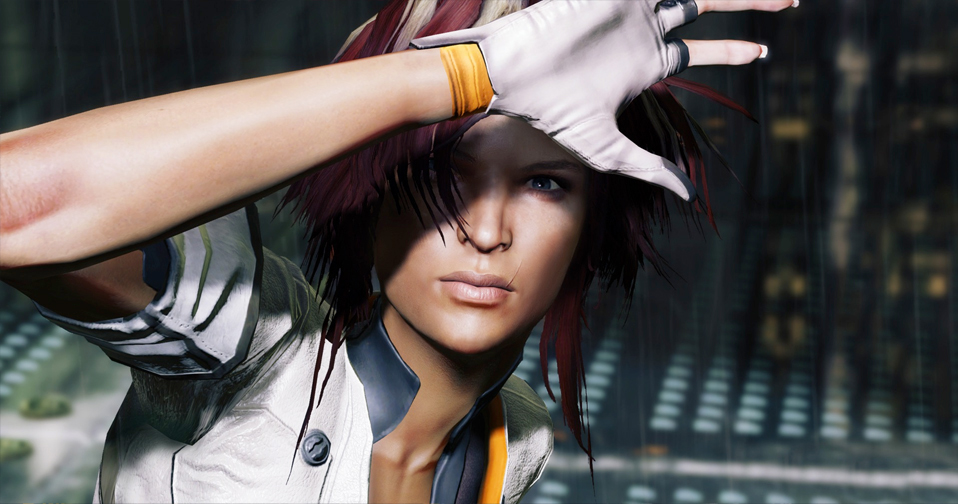I won’t soon forget Neo-Paris, nor Nilin, the woman whose tragic story plays out in a clouded virtual reality across the rich streets of the city’s lower quarters and the lonesome, lifeless halls where its affluent citizens live and work in a society built on a multinational corporation’s business of playing God with the population’s digitized memories. The initially opaque mission is full of revelation, and calls motivations and morality into question as Nilin peels back the layers of truth behind her own criminal imprisonment and subsequent escape, and the ongoing revolutionary uprising against a civic order that thrives on thought-manipulation and the evolution and ambiguity of shared media. George Orwell lurks in the shadows.

The story engages from the outset, drawing players in as Nilin learns more about herself and her city, primarily through the guidance of a mysterious voice in her ear. The voice belongs to Edge, the leader of the underground Errorist movement against the new way of life introduced by a company called Memorize and its ubiquitous memory technology following the ravages of the 2040-2047 Civil War on the capital city. Nilin’s path through Neo-Paris is linear and without distraction, and the lack of interactivity in the game world casts her as an observer or even a trespasser in the socio-economically dichotomous city so richly detailed that it speaks its past and present as she passes through its slums, markets, residential areas, and business districts, often while blaring news reports reinforce the culture of media obsession and suggestion. Despite Nilin’s strength and resolve, however, the narrative loses momentum in its latter half, as the game fills halls with throngs of guards and adds a few nonessential, ill-fitting components of play that simply feel like stalling.

Remember Me deserves praise for efficiently packaging experimental play mechanics with adapted versions of proven ones, and the early goings feature complimentary proportions of clean, low-risk platforming and urban traversal, combo-driven melee combat with a unique customization aspect, and narrative segments to drive the plot forward with a sense of urgency. Remember Me‘s creative and original Memory Remixes make the narrative interactive by allowing players to alter a combination of details in scenes that represent specific memories in certain non-player characters’ minds. Nilin rewinds, fast-forwards, makes changes, and watches the consequences play out, while the newly created memories alter the mentally “hacked” characters’ actions in the forthcoming portions of the story. The first encounter with such a sequence is impressive and memorable, and this aspect of play colors the overall experience, even in the presence of other deficiencies.
Combat in Remember Me is reminiscent of Batman: Arkham Asylum, with many enemies attacking Nilin at once as the player executes smooth combos between artful dodges when bright red exclamation points signal incoming attacks. Offensive strikes have one of three effects: damage, health regeneration, and special attack cool-down reduction. Customizing Nilin’s combos using a limited number of each of these types of strikes creates an interesting metagame during combat, allowing players to efficiently manage the effects on Nilin’s own status, as well as enemy punishment. Tinkering with combos allows for personal strategy in one’s approach to enemy encounters, and can be re-evaluated and altered at any time to better serve the player.

Where Remember Me‘s combat falls short is in the disruption caused by dodging instead of countering, as in the Batman or Assassin’s Creed games. Even with a wheel of five special abilities ranging from a short-lived fury mode, to turning enemies against one another, to a digitally cloaked instant kill, all of which are both useful and spectacular, Nilin is never as poetically fierce and deadly a warrior as the heroes of those other games. It doesn’t help her cause that analog controls are imprecise and the game’s camera is untamable during close-quarters combat situations, or that later stages introduce these roadblocks too frequently.
Uninspired, tedious use of a telekinesis ability feels shoehorned into the last third of the game. While such a power has been used in other games to great effect, Remember Me implements the ability only to perform menial tasks. Sliding numerous door shutters open or shifting parts of the environment that Nilin could easily walk up to and interact with by pressing the Circle button (B on 360) are not compelling reasons to ask the player to manipulate the power in this non-expeditious way. Rarely does the power feel necessary or rewarding.

There is also a chase scene late in the game that is surely meant to increase tension, but feels out of alignment with the rest of the game, which has a clearer philosophy about navigating the world and engaging with the narrative through the strength of its expressive lead character. Nilin’s sense of abandonment from the world at large after the erasure of her memories, her seemingly blind faith in Edge’s instruction brought on by her desire to achieve some resolution and sense of wholeness or belonging, and her soliloquies punctuating each chapter of the story, are what inspire a player’s commitment to the fiction — not a growling helicopter chasing her through a series of convoluted corridors and contrived climbing segments.
Still, the lasting impression of Remember Me is an ambitious, imaginative, and experimental project that piques interest with an enjoyable story of an endearing heroine. Whether the game lacks great depth and its ending lacks sophistication, or its secondary characters spout a few lines of hokey dialogue, aren’t of chief concern because freshman developer DONTNOD has worked to produce something different, and has in turn created a game worth remembering.



















